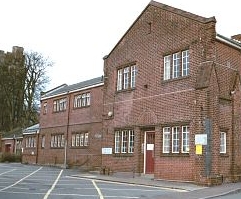|
Bures-online.co.uk |
|
 |
|
|
||||
|
|
By the mid 1830`s all
of the Bures residents were transferred to Sudbury.
This page gives a very brief history of the Sudbury Institution.  Walnutree Hospital (Sudbury Workhouse) 2008 |
|
The first workhouse in Sudbury opened
in 1702, by renting St Gregory`s College an ex 14th monastery (now the
site of St Gregory`s Church) The Poor Law came about because there was a depression with thousands unemployed, and the villages could not cope with so many destitute people. Parishioners were fed up with paying to much tax to keep these people fed and housed. Many took advantage of the system and let the local workhouse look after them. The new law provided for one central workhouse to replace the multitude of parish workhouses. The area covered by the central workhouse was known as a Union. A new Sudbury Poor Law Union was formed on 24th September 1835. Its operation was overseen by an elected Board of Guardians, representing the 42 parishes it covered, 24 Suffolk parishes and 18 in Essex The Workhouse
we know today as Walnutree was built in 1837 at a cost of £10,000
to accommodate 400 inmates The registered Guardians in 1856 from Bures St Mary were Mr H. Westropp and from Bures Hamlet, Mr C. Pettit The 1881 census recorded,121 men, 14
boys, 69 women and 11 girls. Workhouses were more like prisons life
was harsh mainly to deter spongers, they were made to feel shameful
and humiliated, there was no sympathy whatsoever. Inmates were categorised into seven sections Women paupers were put to work with domestic
chores, knitting sowing spinning The paupers who died at the workhouse were not given a church service because of the cost, a short service was held in the graveyard where they were most probably buried away from other people, in a piece of rough ground The Public Assistance Act of 1929 saw
the Union Workhouse was taken over by Suffolk County Council The 1938 census recorded, 48 males, 15
females, 3 children. The census did not include vagrants. These were
deemed a nuisance and actively discouraged from entering the workhouse NHS was launched in July 1948 and the
Institution renamed "Sudbury Walnutree Hospital, Again because
of the number of inmates (8 left) it did not shake of its Workhouse
status. No more vagrants/tramps were admitted Lily Ambrose was the last inmate at Walnutree, she was born in Hartest 1898, entered the establishment in 1914 and finally died in 1985, the last destitute person to be there - end of an era CLICK HERE for the 1881 census of residents taken at the Sudbury Workhouse. It records a child of 1 month with its unmarried mother and other elderly residents up to 91 years of age. This makes very distressing reading, when you consider the age range. Bures residents listed at the Sudbury Workhouse in 1881.
Reference:- |